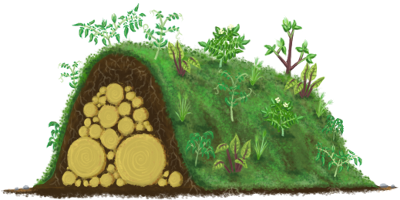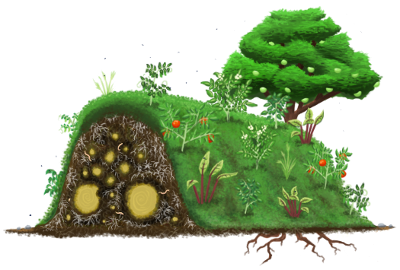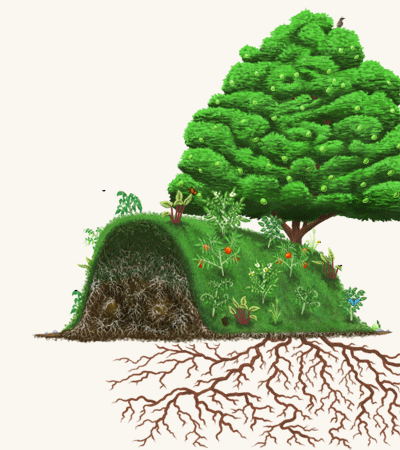- grow a typical garden without irrigation or fertilization
- has been demonstrated to work in deserts as well as backyards
- use up rotting wood, twigs, branches and even whole trees that would otherwise go to the dump or be burned
- it is pretty much nothing more than buried wood
- can be flush with the ground, although raised garden beds are typically better
- can start small, and be added to later
- can always be small - although bigger is better
- You can save the world from global warming by doing carbon sequestration in your own back yard!
- perfect for places that have had trees blown over by storms
- can help end world hunger
- give a gift to your future
Hugelkultur: article below from the website http://www.richsoil.com/hugelkultur/
a page on permaculture methods
garden beds: hugelkultur instead of irrigation

raised garden bed hugelkultur after one month

raised garden bed hugelkultur after one year

raised garden bed hugelkultur after two years

raised garden bed hugelkultur after twenty years
hugelkultur raised garden beds in a nutshell:
Jerome ran across hugelkultur in a Sepp Holzer book on Permaculture. We have a lot of tall weeds and some rotten wood around the farm. As mentioned above there are many immediate benefits as well as carbon sequestering. Carbon sequestering helps to prevent further buildup of Carbon in the atmosphere from the decay of the wood. In a way lessening the growth of the greenhouse effect in the atmosphere.
The compost that we added on the top of our raised beds on wood/woody weeds is from the city of Davenport. The city has a compost facility where residents can drop off "yard waste". They then compost these clippings and sell the compost. I like the idea of supporting a city compost system.
I looked into the different organic mixes the city offered. One was mixed with sludge from city waste facilities sometimes referred to as "biosolids" (though biosolids are sometimes differentiated as having gone through more of a treatment process than the general term "sludge"). There seems to be quite a controversy about gardening with sludge. This link shows a little about the sludge controversy. We got the compost without sludge, but unfortunately this type no longer comes in bulk. We will, however be re-using the bags in the bottom of our pounded tires.
The beds in this picture are planted with lettuce, kale, and swiss chard. If you look closely at the top of the photo you can see some of the rotten wood we are putting inside the piles. These beds are between buildings where the greens will receive partial shade. Last year the heat caused our lettuce to bolt pretty quickly in the sun, but this year it will be more shaded.


No comments:
Post a Comment